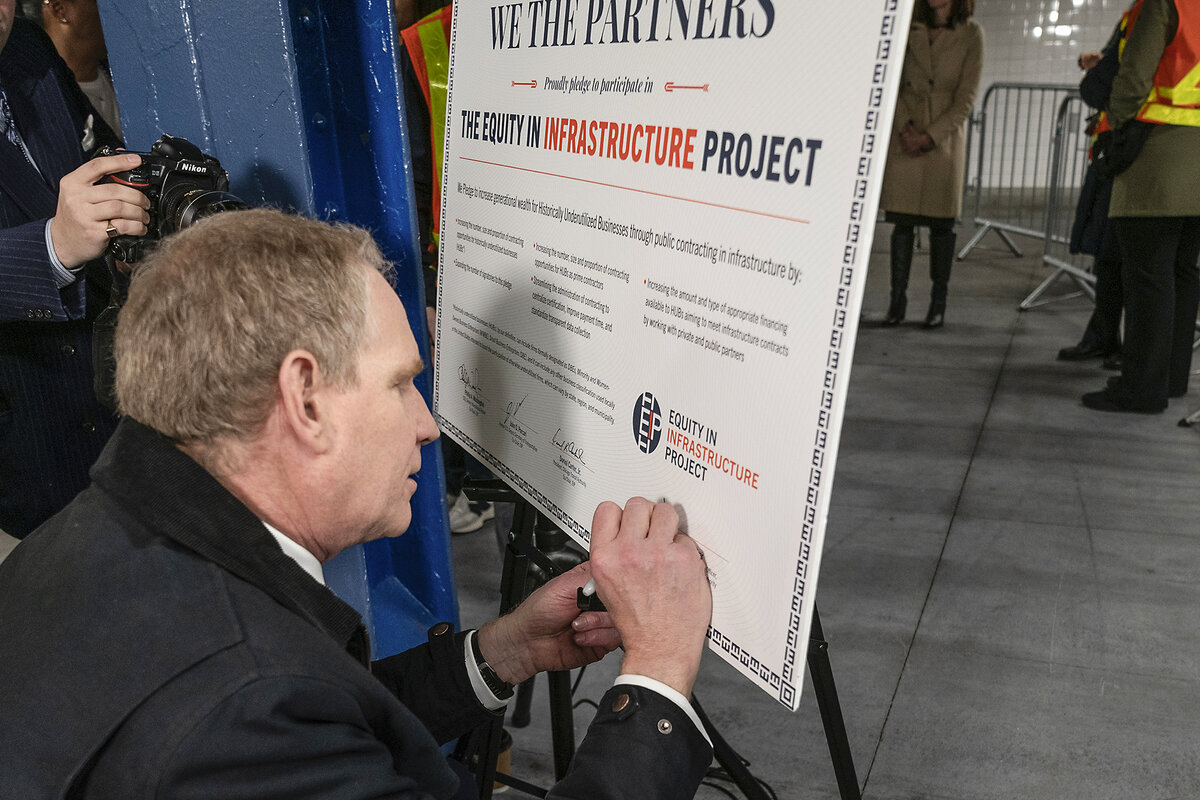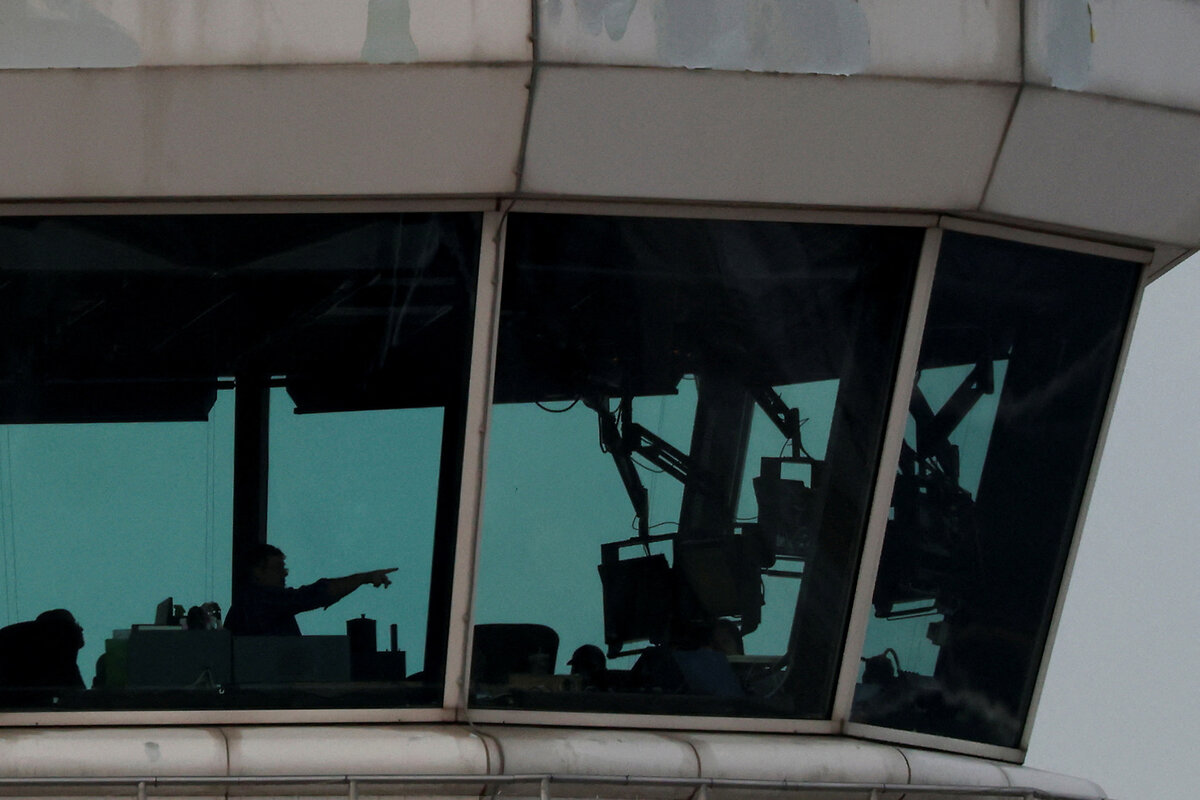Trump is attacking DEI in government and beyond. What will be the impact?
Loading...
As President Donald Trump wields his executive powers over the federal bureaucracy and private entities that do business with the government, one target in particular has been front and center: programs promoting diversity, equity, and inclusion, or DEI.
During his first two weeks in office, Mr. Trump has issued several executive orders to stamp out DEI – which he and his allies describe as a harmful and pervasive ideology – both inside and outside the federal government. He put all federal DEI employees on administrative leave and ordered agencies to eliminate their positions. A separate executive order was issued to end diversity programs in the military. The administration also rescinded a 1965 executive order by President Lyndon Johnson mandating affirmative action for federal contracts, and put contractors on notice to terminate any “illegal” DEI programs.
In the aftermath of last week’s fatal midair collision between a passenger jet and a military helicopter in Washington, Mr. Trump accused his Democratic predecessors of promoting diversity over merit in the United States’ air traffic control system. Before the crash, he had signed an executive order to end DEI programs in the Federal Aviation Administration (FAA).
Why We Wrote This
President Donald Trump and his supporters see diversity, equity, and inclusion programs as discriminatory and counterproductive. But his scorched-earth tactics to end DEI are generating criticism and sharpening political divisions.
By attacking diversity initiatives, President Trump is riding a cultural backlash – one that he has helped to foment. His supporters and even some moderate voters see DEI programs in public and private institutions as discriminatory and counterproductive, an outgrowth of Democratic identity politics that went too far in highlighting racial and other differences, to detrimental effect. At the same time, the president’s full-throttle use of executive powers to go after DEI, including inserting it into an aviation tragedy before any evidence emerged, is already generating criticism and sharpening political divisions.
The pushback against DEI – a catchall term for programs used to recruit and mentor a diverse workforce and student body, as well as tackle institutional bias and discrimination – precedes Mr. Trump’s return to office. A turning point was a 2023 ruling by the U.S. Supreme Court that barred race-conscious admissions of students at universities. Republican-run states such as Florida and Texas have passed laws to prohibit all DEI programs in public universities in their states.
Over the past year, some companies that had announced or ramped up diversity initiatives in 2020 during national racial justice protests have begun to end or scale back their programs. Conservative legal activists who sued over race-based university admissions have also filed legal challenges to diversity efforts at private companies and nonprofits over alleged discrimination.
Now such efforts have the backing of the Trump administration, which has explicitly tasked federal agencies with investigating large companies, philanthropic foundations, and wealthy universities for possible violations of federal law in their diversity programs. One of Mr. Trump’s executive orders called for each government agency to prepare up to nine civil investigation targets, along with “other strategies to encourage the private sector to end illegal DEI discrimination and preferences.”
Companies won’t want to be among the administration’s targets, says Kenji Yoshino, a law professor at New York University and director of its Center for Diversity, Inclusion, and Belonging. “It’s almost a reverse ‘Apprentice.’ Instead of everyone competing to be the apprentice, everyone’s competing not to be on that list,” he says, referring to Mr. Trump’s former reality show.
This represents an escalation in the anti-DEI movement, says Professor Yoshino, who teaches constitutional law, because it involves the enforcement power of the executive branch. “So now, rather than an individual private litigant who says, ‘I’m disgruntled about this policy; I feel like I’m treated unfairly’ – instead of forcing that person to bear the costs of a lawsuit, you have now the federal government opening up these investigations.”
Although public support for DEI has ebbed a bit, as of October 2024 about 52% of U.S. workers said that focusing on DEI in the workplace is “a good thing,” versus 21% who called it “a bad thing,” according to a Pew Research Center survey.
Not all companies are abandoning DEI, says Ana Duarte McCarthy, a consultant and former chief diversity officer at Citigroup. She cites Costco as an example of a Fortune 500 company that has publicly reaffirmed its commitment to diversity and inclusion. But companies that once saw those efforts as unequivocally good for public relations are now navigating a different environment, in which the federal government uses words like “immoral” to describe DEI initiatives, she says. “This makes the narrative very different from its origin, which was equality and opportunity.”
Remedy to discrimination or “consultancy grift”?
In the thorny debate over diversity, DEI is often equated with affirmative action for underrepresented groups. But many workers have encountered DEI not in hiring practices but through personnel workshops and training programs that, however well intentioned, have been criticized as progressive groupthink, as well as a waste of time and money.
Opponents have alighted on these frustrations as a practical reason to do away with such programs, particularly in public institutions. “DEI is designed to favor ideologues and consultancy grift instead of competent or public-spirited officials,” writes Christopher Rufo, a prominent DEI critic, in a recent article for City Journal.
Affirmative action – the hiring and promoting of individuals from certain marginalized groups, such as racial minorities – has long been a touchy subject in a democracy that for most of its history was explicitly white-ruled and male-dominated.
In his executive order to rescind the 1965 directive on affirmative action, Mr. Trump said that “illegal DEI” policies undermined “the traditional American values of hard work, excellence, and individual achievement” and shut out Americans “because of their race and sex.” Critics of DEI say the purpose of affirmative rights regulations in the civil rights era was to end discrimination against people of color at a time when such discrimination was a serious, pervasive problem – and not to engineer equal representation in ways that would undermine merit-based advancement for everyone. On an individual level, they say, it can result in reverse discrimination against white people, as the majority group in society.
One example is a class action lawsuit against the FAA alleging that more than 2,000 qualified air traffic control applicants were sidelined during the Obama administration because the agency had a goal of recruiting more nonwhite air traffic controllers. Last Thursday, Mr. Trump implied this policy – along with an initiative to hire people with disabilities – was to blame for the airline crash, though he later allowed he wasn’t sure. Analysts say the FAA has struggled for years to keep pace with demand for air traffic controllers in congested skies.
Former Biden Transportation Secretary Pete Buttigieg called Mr. Trump’s comments “despicable,” writing in a post on the social media site X, “To be abundantly clear: we did not change the rigorous standard for becoming a certified air traffic controller. Those claiming otherwise are mistaken or lying.”
Unclear how many jobs may be affected
Defenders say the goal of affirmative action, as it applies to federal contractors, is to open doors for women, people of color, veterans, and other groups that might not otherwise win bids, given historically unequal structures in place. More broadly, they credit affirmative action for helping to advance women in professions such as law and medicine that had once been largely reserved for men. In the corporate sector, executives have argued that greater diversity in the workforce is good for making decisions and for doing business.
The 1965 affirmative action directive, which was later expanded to include more categories of protected groups, including sexual orientation, covered government contracts worth over $100 billion annually. Experts say this could be among the most consequential of Mr. Trump’s executive orders, in terms of its impact on companies and their workers.
“It’s the linchpin of the modern equal employment opportunity” system that government contractors follow, says James Paretti Jr., an employment lawyer at Littler in Washington.
As head of the executive branch, Mr. Trump has wide scope to end DEI practices in federal agencies – though it’s unclear how many jobs will actually be eliminated by those executive orders. One agency, the Department of Veterans Affairs, which has more than 400,000 employees, second only to the Department of Defense, said it had put some 60 people on paid leave. Other agencies had even lower counts of DEI-related positions, The Wall Street Journal reported.
Outside consulting firms, which expanded rapidly in recent years to satisfy demand for workplace training, may be more affected.
Under President Joe Biden, federal agencies were required to issue annual progress reports on diversity goals and to provide demographic data for a public dashboard. In 2022, the government said that the federal workforce was about 60% white and 55% male overall. Among senior executives, the share of white employees was more than 75%.
The American Federation of Government Employees points out that the public workforce is more diverse and has much lower gender and racial pay gaps than the private sector does, a sign of success in its approach to diversity. And it says that talent and excellence have not been sacrificed along the way. “The federal government already hires and promotes exclusively on the basis of merit,” said the federation’s president, Everett Kelley, in a statement.
As the Trump administration’s rooting out of DEI programs in the federal government gathers pace, Mr. Paretti, the attorney, has been fielding calls from executives who do business with the federal government to inquire if their DEI programs violate the new rules.
He says companies don’t have to tear up their diversification strategies entirely. “There are still many lawful things you can do to ensure that you’re getting a diverse and talented pipeline of applicants,” he says.








